Handheld Hygrometers, Psychrometers & WBGTs
Measure relative humidity and ensure environments maintain a balanced ecosytem with our range of temperature, air and humidity meters. Also includes humidity and moisture sensors and relative humidity meters.
Find out more about Handheld Hygrometers, Psychrometers & WBGTs below.
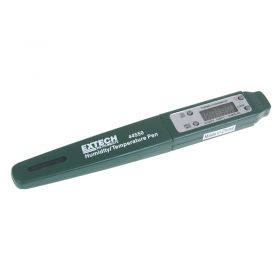
- Pen-shaped
- Measures RH and temperature at same time
- Pocket sized
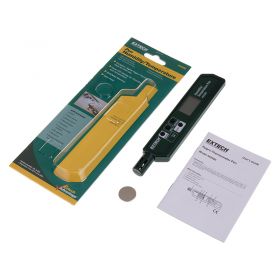
- Simultaneous display of Temperature (°C/°F) and Relative Humidity
- Max/Min and Data Hold
- Built-in self calibration utility allows for field calibrations using optional Relative Humidity calibration bottles
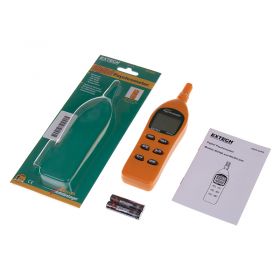
- Wet bulb measurements without slinging
- Calculates T1-T2 differential (Air Temperature-External Probe Temperature) using optional probe
- Unique sensor cap design twists to closed position for protection during storage
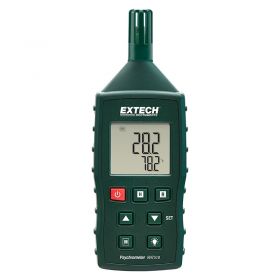
- Compatible with a range of probes
- Suitable for residential and professional settings
- Easy to use
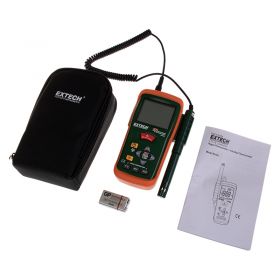
- Combination Humidity meter plus Infrared Thermometer
- IR or Humidity primary display i& ambient temperature secondary display
- Infrared thermometer has built-in laser pointer and an 8:1 distance to target ratio
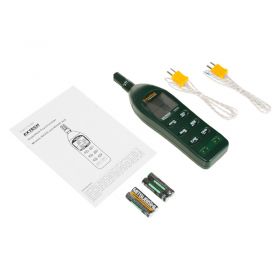
- Dual Type K external temperature probe input
- Simultaneous display of measurements
- Built-in RS-232 interface (optional RS-232 cable)
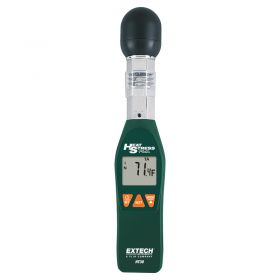
- Heat Stress Index
- Monitors the effects of direct solarradiation on an exposed surface
- In/Out Function displays the WGBT value with or without direct sun exposure
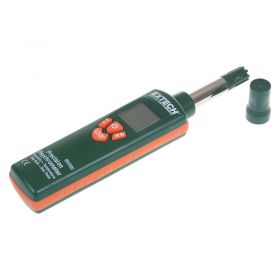
- Dual backlit display
- Simultaneous display of: Humidity/Temperature, Humidity/Dew Point or Humidity/Wet Bulb
- Data Hold and Min/Max functions
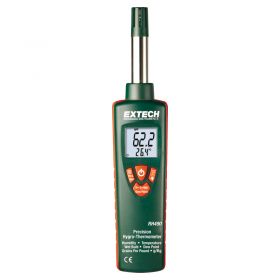
- Water vapor in GPP
- Simultaneous display of: Humidity/Temperature, Humidity/Dew Point or Humidity/Wet Bulb
- Data Hold and Min/Max functions
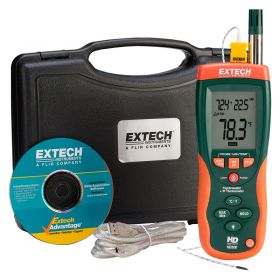
- Built-in InfraRed Thermometer for non-contact temperature measurement to 932°F (500°C)
- IR Thermometer: 30:1 distance to target ratio
- Type K Thermometer for contact temperature measurement to 2501°F (1372°C)
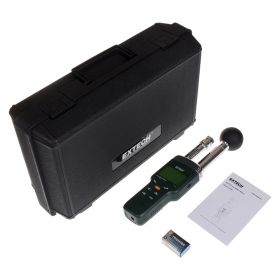
- Measures exactly how hot it feels outside using many different measurements
- Calculates wet bulb globe temp, black globe temp, air temp, relative humidity, dew point and wet bulb
- Memory storage for up to 50 readings
About Handheld Hygrometers, Psychrometers & WBGTs
Our environment is made of several different elements. While we generally think of oxygen, carbon dioxide, and even nitrogen as forming the bulk of the Earth's atmosphere, the water content in the air is also constantly present. A good quality humidity tester is useful for those who routinely find themselves working in humid environments.
If you've got a lot of people working in one place, keeping the humidity in check is essential. Many people become uncomfortable in humid environments and can even suffer adverse health effects if they are exposed for long enough periods. Asthmatics are particularly affected by humid environments.
It is therefore important for you to regularly test the humidity of an environment to ensure the safety of yourself and your workforce.
High humidity, along with temperature, also affects electronic circuits and machinery, so if you want to keep your installation working within safe limits a hygrometer will be a worthwhile investment. Here are some of the effects you can expect:
|
Component |
Temperature Effect |
Humidity Effect |
|
Ceramic capacitors |
Changes in dielectric constant and capacitance lowered insulation resistance with high temp. |
- |
|
Electrolytic capacitors |
Increased electrolyte leakage; shortened life, a large change in capacitance, increased series resistance with low temp. |
Decreased insulation resistance increased dielectric breakdown increase in shorts |
|
Tantalum Capacitors |
Electrolyte leakage; change in capacitance insulation resistance; series resistance |
Decreased insulation resistance increased dielectric breakdown increase in shorts |
|
Transistors |
Increased leakage current; changes in gain; increases in opens and shorts |
Increased leakage current; decreased current gain, if sealed not effect |
|
Standard Connectors |
Flashover, dielectric damage |
Shorts fungus; corrosion of contacts lowered insulation resistance |
|
Crystals |
Drift |
Drift |
|
Switches |
Oxidation of contacts |
Contact arcing |
|
Thermistors |
Increased shorts and opens |
Change in resistance |
Humidity sensors are also quite commonly referred to as hygrometers. These devices are generally defined into two separate types - humidity meters and humidity sensors. The major difference between the two is that humidity meters are designed as handheld, portable instruments to be carried out and test various applications; a humidity sensor is designed to be mounted in one location such as a wall, and will constantly catalogue the humidity (and other parameters such as temperature) in the environment it is placed in.
A humidity sensor is an extremely beneficial tool in a wide variety of applications. Whether it's simply maintaining the humidity levels in an office or ensuring that excessive water content isn't in the air when storing delicate materials such as wood, these sensors help to alert users when humidity is too high and action must be taken.
Many humidity meters include the ability to measure dewpoint, which is basically when water vapour in an area starts to condense into liquid water. By determining this value users can ensure that humidity in the air doesn't get the chance to turn into water, and this in turn increases safety and stops damage to properties and components.


